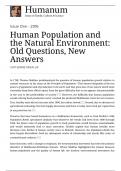Humanum
Issues in Family, Culture & Science
Human Population and
Issue One - 2016
the Natural Environment:
Old Questions, New
Answers
CATHERINE PAKALUK
In 1798, Thomas Malthus problematized the question of human population growth relative to
natural resources in his essay on the Principle of Population: “This natural inequality of the two
powers of population and of production in the earth, and that great law of our nature which must
constantly keep their effects equal, form the great difficulty that to me appears insurmountable
in the way to the perfectibility of society.”[1] However, the difficulty that human population
would outstrip food production never reached the predicted Malthusian crisis for two reasons.
First, fertility rates did not increase after 1800, but rather slowed.[2] Second, due to advances in
agricultural technology, the food supply increased, and there is today more food per capita than
in any previous era.[3]
Theories that later based themselves on a Malthusian framework, such as Paul Ehrlich’s 1968
Population Bomb, speculated similarly that whatever the trends had been from 1800 through
1950, the future ratio of population growth to food production would become unsustainable,
and would ultimately lead to mass starvation. Ehrlich argued that human fertility must
decrease even further if human society were to flourish. However, the Population Bomb has
been largely discredited—both by subsequent works of scholarship and nearly fifty years of
counterfactual evidence.[4]
Since that time, with a change in emphasis, the environmental movement has been the primary
inheritor of Malthusian-Ehrlichian rhetoric. Where Malthus highlighted the tension between
human population and the quality of human life, the modern environmental movement has
, instead advanced a paradigm that sets human population in competition with the quality of the
natural environment. This latter is aimed not at the problem of human flourishing, but at the
problem of natural flourishing, understood to mean primarily the health and proliferation of
plants, wildlife and various habitats.[5] To wit, “Since the early 1970s, many researchers have
found correlations between [human] population size and impacts on resources including water,
air, and plant and wildlife species.”[6] For this reason, activists working from within the
environmental paradigm have tended to encourage limitations on human fertility and birth,
like Erlich, considering birth control to be environmentally friendly.[7]
The picture has become gradually more complex, however. To begin with, chemical-hormonal
contraceptives have come under scrutiny for emerging adverse effects of estrogenic compounds
on both natural and human ecology.[8] Moreover, environmental scholars have begun to argue
that the paradigm pitting human population against natural environment is itself overly
simplistic regarding the true relationship between human and ecological populations. In the
remainder of this essay, we draw attention to some contemporary studies that help to
characterize more accurately the relationship between human population and environmental
health.
~
In 2014, conservation biologists Mason Bradbury and Jianguo Liu from the Department of
Fisheries and Wildlife at Michigan State University, together with M. Nils Peterson from the
Fisheries, Wildlife, and Conservation Biology Program at North Carolina State University,
proposed a new equation for estimating the human impact on the environment.[9]
Where prior scholarly work estimated various models of the impact of human population per se
on environmental outcomes, Bradbury, Liu, and Peterson found that the absolute number of
households (and not the absolute number of people) was an equivalent, and in some cases
better, predictor of environmental impact.[10] They observed that variation in the grouping of
people into households determined consumption, waste, and impact.[11] Both the overall
number of households and the average household size were predictive of the consumption of
natural resources and environmental impact.
The importance of this discovery is clear given the recent observation that although “population
growth…is slowing and even reversing in some places,”[12] this “has not translated into
reducing human consumption of natural resources and impact on the environment.”[13] The
authors state:
The number of households is often equal to, or better than, population at predicting CO2
emissions […] fuelwood […] per capita automobile use […] and species endangerment. For
example, population growth accounted for only one-fourth of increased energy consumption in the
1970s and 1980s, whereas the remaining 3/4 was related to per capita increases driven largely by




